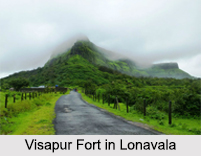 Lonavala is a hill station and one of the important tourist spots in the Pune district of Maharashtra. It is situated at the height of 2047 feet from sea level and spreads over 38 km square of land. It is popular for its production of a kind of candy called “chikki†and a major stop on the railway line connecting Mumbai and Pune. The name is derived from Sanskrit words, “leni†meaning caves and “avail†which means series. So the combination of both the words means “a series of cavesâ€. Lonavala offers an escape to the visitors from extreme conditions of city life with its serenity and comfortable atmosphere.
Lonavala is a hill station and one of the important tourist spots in the Pune district of Maharashtra. It is situated at the height of 2047 feet from sea level and spreads over 38 km square of land. It is popular for its production of a kind of candy called “chikki†and a major stop on the railway line connecting Mumbai and Pune. The name is derived from Sanskrit words, “leni†meaning caves and “avail†which means series. So the combination of both the words means “a series of cavesâ€. Lonavala offers an escape to the visitors from extreme conditions of city life with its serenity and comfortable atmosphere.
History of Lonavala
Lonavala was a part of the Yadava dynasty. Later, the Mughals ruled the region for an extended period of time realizing the strategic importance of the place. The Maratha and Peshwa empires played a significant role in the region along with the Malva warriors. The surrounding hills of Lonavala were the monopoly of the Maratha rulers in the late medieval era. History says that the Maratha rulers practiced guerrilla warfare from here against the Mughals and later the British. In 1871, Lord Elphinstone, the then Governor of the Bombay Presidency developed the Lonavala and Khandala hill stations.
 Climate of Lonavala
Climate of Lonavala
The city of Lonavala has a tropical climate. It lies on 624m above sea level. The average rainfall here is 4073mm. There is significant rainfall in most of the months of the year and the dry season has little effect in the region. The least amount of rainfall occurs in the month of January and most of the precipitation is experienced in July, averaging 1719 mm. January is the coldest month in the region with an average of 20.9 degree Celsius and the average highest temperature at around 27.9 degree Celsius occurs in May.
Location of Lonavala
Lonavala is located amongst the sylvan hills of the Western Ghats and is a popular gateway from Mumbai and Pune. Lonavala lies in the western part of Maharashtra, in the western region of India. It is set amongst the slopes of the Sahyadris Mountain Range and situated at 106 km southeast of Mumbai. The place offers the tourists a wide array of pristine woods, green valleys, gushing waterfalls, historic caves and scenic panorama.
 Tourism in Lonavala
Tourism in Lonavala
Lonavala and the adjacent Khandala are twin hill stations that attract a number of tourists. Tourists flock the place mostly during monsoon which is also the peak time for visitors. A trip to Lonavala can include sight-seeing in Karla, Bhaja and Bedsa caves and also two fortresses, Lohagad and Visapur. Another place of significance is the Tungi fort, one of the forts captured by Malik Ahmad near the village of Karjat. The Andharban trek starts from the village of Pimpri and passes through dense forests, valleys, waterfalls and ends in Bhira. The entire place consists of picturesque lakes, cliff-tops, eluding caves and magnificent forts. Other places of interest around Lonavala include Rajmachi Point, Valvan Dam, Della Adventure Park, Ryewood Park and Shivaji Udyan, Lonavala Lake, Tiger"s Leap, Duke"s Nose, Bhushi Dam, Lion Point, Tungrali Dam, Seven Villas, etc.
Travelers can take a walk along the waterfalls, the grassy abundance and hills in and around Lonavala. The mountainous terrain of Lonavala is ideal for trekking and hiking. The quaint exquisiteness of Lonavala is enhanced by the numerous lakes around the place. Tugauli, Lonavala and Bhushi lakes are worth visiting and so is the Walvan Dam. Another place worth visiting is Lion`s point that lies between Bhusi Dam and Amby Valley. Tiger"s Leap or Vaghdari is a cliff-top that offers panoramic view of the valley. Here echo-point is the most famous one and travelers tend to trek to enjoy the adventure.
 Khandala Dari is an amazing place to go for trekking and hiking. The unparallel beauty of the place is pleasing to the eyes of the visitors. One can trek through the Monkey Hill to reach Gambhirnath Caves, which can be an additional site to visit.
Khandala Dari is an amazing place to go for trekking and hiking. The unparallel beauty of the place is pleasing to the eyes of the visitors. One can trek through the Monkey Hill to reach Gambhirnath Caves, which can be an additional site to visit.
Pilgrimages near Lonavala
The area around Lonavala was an important Buddhist centre in 2nd century BC and a number of ancient Buddhist cave temples can be found in the environs like rock cut caves of Bhaja, Bedsa and Karla. Apart from caves, there are a few temples near Lonavala which are popular for splendid beauty and spirituality such as Ekvira Devi Temple, Bhairavnath Temple, Shivling Darshan etc. Kaivalyadhama Yoga Hospital is 2 km from Lonavala on the road to Karla and Bhaja caves. This center attracts both local and foreign tourists seeking yogic healing.
Visiting Information about Lonavala
Lonavala is 96 km away from the Mumbai and 64 km from Pune. It lies in between the Mumbai-Pune Expressway, making commutation easier for tourists. One can avail buses, trains and even rental cars to reach here. Train journeys are comfortable with greenery all around.



















